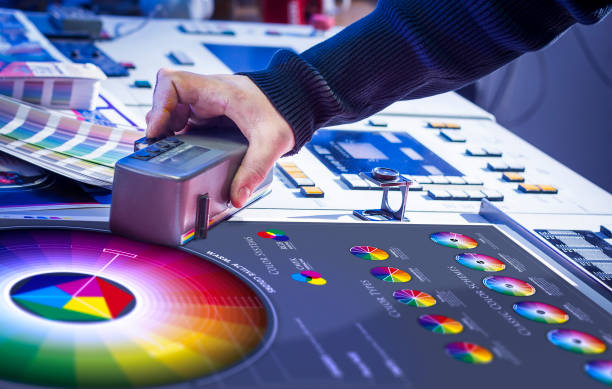
The Australian publishing landscape has changed a lot lately. This is mainly because of new tech that magazine printing companies are adopting. Starting from the rotary press in the 19th century to today’s digital tech, it’s been a huge journey for magazine printing.
Even with the rise of digital media, print magazines are still popular. Some digital firms are even printing magazines to increase their brand impact. This shows that people still love holding printed material, even in a digital age.
The effects of technology on making magazines are big. New heatset and coldset printing methods create better quality prints more efficiently. These changes are also helping reduce the industry’s impact on the environment.
Next, we’ll look at how a progressive magazine printing company is keeping up with digital change. We’ll talk about mixing print and digital, adding personalized content, and using eco-friendly methods. Let’s explore how the magazine publishing world in Australia is changing.
The Evolution of Magazine Printing Technology
The history of magazine printing goes back many years. There have been major changes from the very first movable type to today’s digital systems. Magazine printing has seen huge leaps in technology over time. These advancements have also paved the way for custom magazine printing, offering a variety of options to meet unique project needs.
From Rotary Presses to Digital Printing
In the 19th century, the rotary printing press changed everything. This new press could print fast on continuous rolls of paper. Offset lithography later made prints even better and quicker.
By the 20th century, digital printing was introduced. This brought speed, accuracy in colours, and the ability to print small amounts cost-effectively. Today, many publishers in Australia choose digital magazine printing for its high quality and flexibility.
Advancements in Ink and Paper Technology
Inks and papers have also improved with time. Now inks are brighter, quicker to dry, and better for the environment. Paper manufacturers make papers that make prints look great but are kinder to the planet.
These improvements also contribute to producing an affordable magazine without compromising on quality.
The Rise of Computer-to-Plate (CTP) Systems
CTP systems have changed the game for pre-press work. CTP systems have changed the game for pre-press work, significantly improving the efficiency of any magazine printing project. They send digital files straight to printing plates, removing the need for film. This change has made magazine production smoother, with better quality prints. “The adoption of CTP systems has been a game-changer for our industry, streamlining production and delivering superior results.” As technology keeps advancing, Australian publishers can make topnotch magazines in a more efficient and eco-friendly way.
Digital Disruption in the Magazine Industry
The magazine world has been rocked by the digital wave in recent decades. The rise of the internet has led to a big fall in traditional magazine readership. For instance, in the UK alone, print sales of consumer magazines dropped by about one million in the first half of 2014. The music magazine NME suffered most, with a 28% decline in sales from one year to another.
Going digital didn’t just mean trouble, though. It started a whole new era of online magazines back in the mid-‘90s. Salon, the first of its kind, hit the web in 1995. In no time, it drew in 5.8 million visitors each month. This set off a sprint towards digital in magazine’s world, which has never slowed down.
But, the story isn’t all bad for print. Some publishers chose to make their print issues extra special. They’re using the best materials and crafting an experience you can touch and feel. This has set them apart from the web, providing something that online news can’t.
“Print is not dead; it’s evolving. We’re seeing a renaissance in high-quality, niche publications that offer something unique to readers.”
Australia stands out in this worldwide shake-up. In 2023, print magazine sales actually went up by 4.1%. This spike hints that there’s still love for a good, old-fashioned magazine. The industry isn’t facing its sunset due to digital changes. Instead, it’s on a path to a fresh chapter.
Magazine Printing Companies: Adapting to the Digital Age

The print industry is changing a lot. Magazine printing companies are using new tech to stay important today. They mix new strategies with the latest technologies to do this. These companies are also positioning themselves as cheap magazine printing experts, offering cost-effective solutions without compromising on quality.
Integrating Print and Digital Services
Combining print and digital is key now. These companies offer comprehensive magazine printing services that mix traditional print with new digital methods. This change helps them reach more people and meet different reading preferences.
Personalisation and Custom Magazine Printing
Custom printing is changing how we see magazines. Through variable data printing, each item can have special custom content. This makes readers more involved. 78% of people like engaging with custom content. So, this tech lets magazines make content that fits each person’s interests, making the reading experience better. This technology allows magazines to offer a professional magazine printing service that caters to individual reader preferences.
On-Demand Printing Solutions from Magazine Printing Companies:
Printing things when needed is making a big difference in how magazines are made, offering cheap magazine printing options that reduce waste and inventory costs. This method is good for small prints, which cuts waste and the money tied up in inventory. It’s cost-friendly and doesn’t need expensive plates. This is very useful now since people are buying fewer print magazines than before. “Digital adaptation in the printing industry is not just about survival; it’s about thriving in a new era of publishing.” With these new tech tools, magazine printers are not just keeping up with digital changes. They’re also finding new ways to grow and be creative in the print business.
Sustainability Initiatives from Magazine Printing Companies

The magazine printing industry is going green to cut down on the environmental impact of printed magazines. It’s vital as the UN warns we could need three planets by 2050. In Australia, more than 90% of prints sold are from eco-friendly factories.
Turning to recycling is a key step. Aussies recover over 87% of paper and paperboard, which helps cut waste. Printers are also saving energy. For instance, UV printing uses less ink and energy, lowering CO2 emissions.
Now, new ideas are surfacing to be even more sustainable:
- Soy-based inks emit fewer VOCs, making the air cleaner
- FSC™ and PEFC certified papers promote sustainable forestry
- PUR binding needs 70% less glue than perfect binding
- Carbon balanced printing cancels out production emissions
These efforts are not just good for the planet. They also catch the eye of buyers. A study found two-thirds of people think about sustainability when they shop. By going green, magazine printers in Australia are meeting this demand and lowering their impact on nature.
The Role of Automation in Modern Magazine Printing
Automation has changed how magazines are made, making production smoother. Printers now look for ways to print without spending too much. They use new methods to cut costs and print better. Automation also ensures that bound magazines are produced with consistent quality and efficiency.
Streamlining Production Processes
Printing magazines efficiently is crucial today. Systems like Heidelberg’s ‘Push to Stop’ are used. They need less manual work, making production faster and cheaper without lowering the quality.
Reducing Human Error and Enhancing Efficiency
Less human work means fewer mistakes in magazine printing. This new way helps keep each magazine the same, improving quality. It also speeds up the printing process, making it more efficient.
Cost-Effective Solutions for Publishers
Automation saves money for magazine makers. It makes printing cheaper without cutting corners on quality. This helps magazines keep their prices low, even though they face competition from digital media.
- Automated systems handle tasks like imposition, cutting, folding, and binding
- Productivity gains allow for better time allocation for employees
- Cost savings from reduced errors and improved efficiency
Automation in printing has transformed the magazine industry, offering streamlined production processes and cost-effective solutions that benefit both publishers and readers alike.
Quality Enhancements Through Technological Innovations
Recent years have brought remarkable changes to the printing world. Technological advancements have improved both print quality and the look of magazines. Magazines today are not just reads; they’re stunning works that draw readers in with visuals. Technological advancements have also improved binding options, making saddle stitched magazines a popular choice for their durability and aesthetic appeal.
Today, printing can achieve top-notch quality in many ways. They use materials like plastics, resins, ceramics, and even stem cells. These choices open new doors for magazine makers to play with how their magazines feel and look.
3D printing is making waves in creating magazines. It lets magazines have unique covers and inserts. Everything becomes easier with 3D printing, from designing to making, and even the final look of the product. “The future of magazine printing lies in embracing new technologies to create immersive reading experiences.” There’s also nanographic printing turning things around. It mixes the best of traditional and digital printing, with top-notch quality and speed. With this, magazines can flaunt stunning, life-like images on their pages.
Thanks to these upgrades, magazines have become something special. They boast better quality and looks. Today’s magazines are not just for reading; they are keepsakes that people hold dear.
The Impact of E-readers and Tablets on Print Magazines
In 2010, the iPad changed how we view e-readers and tablets. Many Australians now use these gadgets for magazines. Still, good old print magazines are here to stay. They have found ways to live with digital editions. Despite the rise of digital media, services like booklet printing continue to thrive, offering a tangible reading experience that digital formats can’t replicate.
Changing Reader Preferences
E-readers and tablets brought a big change. People look at magazines in a new light. But, most Aussies, about 72%, prefer the feel of books and magazines in their hands. Even for news, 56% pick up a paper. There’s something special about turning real pages.
Hybrid Publishing Models
Now, you can get your read in any way you like. Publishers offer both printed copies and digital forms. They’ve created websites filled with blogs and podcasts. Print copies, on the other hand, have become a place for deep stories and stunning visuals.
This mix suits everyone, from the tech-savvy to the traditional reader. It’s all about choice.
Print Magazines in a Digital World

Print magazines are making themselves better. They have started using quality paper and improving printing. Many people, 67% in fact, enjoy reading the hard copies more. It’s a nice break from staring at a screen and helps with eye strain for 52%.
Reading a printed magazine is a tactile experience that digital can’t replicate. It’s about the feel of paper, the smell of ink, and the joy of flipping pages.”
Digital and print don’t have to fight. There’s room for both in our hearts. As tech gets better, so do the ways we read. It opens up new chances for publishers and readers to connect in amazing ways.
Data-Driven Decisions by Magazine Printing Companies
Magazine printing companies now use data analytics to change how they work. They study what readers like. Then they make content that fits their audience. Doing this makes readers more excited about the magazines. It also helps the printing process work better. Data analytics play a crucial role in every magazine printing project, helping to tailor content and improve production efficiency.
Think about the Coca-Cola “Share a Coke” project. They put people’s names on bottles. This simple idea made sales and online interest go up a lot. Magazine printers can also use this idea. They can make content and share magazines in ways that match who they know reads them.
Even now, in the time of the internet, printed ads are trusted by most Americans. This happened because print ads are real. They leave a strong memory. “Knowledge is crucial for business success, and using MIS tools can reveal areas of weakness in production processes,” says Alan Dixon, managing director of Workflowz. Printers are using Business Intelligence (BI) tools to be more profitable. These tools look for ways to save money and do things better. Heidelberg’s Prinect Smart BI is one example. It has tools that help see how well sales and service are doing, among other things.
Print and digital together can make responses go up by 20%. This mix helps magazines achieve a strong and effective image. It works well in today’s tough market.
The Future of Magazine Printing Companies
The world of magazine printing is changing fast, thanks to new technologies. This change will bring big shifts over the next few years. It’s all about new ideas and what people want to read. The future of the industry will see a rise in custom magazine printing, offering personalized options to meet diverse reader preferences.
Emerging Technologies and Their Potential Impact
Digital printing is changing how magazines are made. It makes printing cheaper at the start, which is good for publishers. Now, you can print just a few copies and still keep costs low. This means less waste and fewer magazines sitting in storage.
Predictions for the Next Decade
Experts think the industry will keep going green and getting more personal. Digital printing is better for the planet. It doesn’t create as much waste. Plus, people love magazines that are made just for them.
Adding things like QR codes and virtual reality makes magazines more fun to read. It’s all about keeping readers interested.
Opportunities for Growth and Innovation
New ways of printing are creating cool chances for magazines. You can now have magazines that open in surprising ways or look different. This makes reading more exciting.
Also, using data to make decisions is becoming very important. Publishers can now learn a lot about who reads their magazines. This helps them make magazines that people really want.
“The future of magazine printing lies in embracing digital technologies and sustainable practices. Companies that adapt will thrive in this evolving landscape.”
Despite some tough times, the magazine world is still strong. Special magazines, like those for kids, are doing well. By using new tech and making magazines unique and good for the planet, companies will do great.
Case Study: MVP Print’s Technological Transformation

MVP Print is a top Australian printing company known for leading with printing innovations. They’ve shown how new tech can change the whole printing game. Their range of services includes high-quality saddle stitched booklets, catering to various printing needs.
Their journey started by making all their hardware the same. They cut down from 350 devices to 205, all HP. This move made things run smoother and cut down on keeping them up. They also started using special software like OneStop for tracking prints and JetAdvantage for making sure things are safe.
Key to their change was pull printing. Now, to get their prints, people swipe a card at the machine. This makes things more secure and reduces how much paper gets wasted. The system also helps MVP Print spot where they use the most ink and paper. “MVP Print has become our strategic partner, challenging us for continuous improvement,” says Neil Collins, Enterprise Applications Manager at a client company. They are also focused on being greener by swapping out paper work for digital processes. This move saves both money and time. It also makes their printing less bad for the environment.
By changing how they do things, MVP Print is showing other printing companies how to keep up in the digital world. Their focus on using new tech and being efficient and eco-friendly has made them a top choice in Australia’s printing scene.
Conclusion
The magazine printing scene in Australia shines bright with over 7,400 different magazines available. This industry keeps growing, proving its strength against digital change. Companies like MVP Print are meeting new market needs with comprehensive magazine printing services, servicing orders from just 100 copies.
Adapting to technology is crucial for success. Digital printing, without a minimum order, and quick 4-7 day turnaround times are now standard. These services meet the changing needs of publishers both small and large.
The future of magazine printing focuses on customisation and high quality. Publishers can now choose from various paper types and weights. They can also add cover finishes like lamination for a better look, ensuring their product stands out.
Going forward, companies that offer niche magazines and adopt new technology will take the lead. With 45 years in the industry, MVP Print shows that mixing tradition with innovation is the key. This approach guarantees a bright future for Australian magazine printing.








